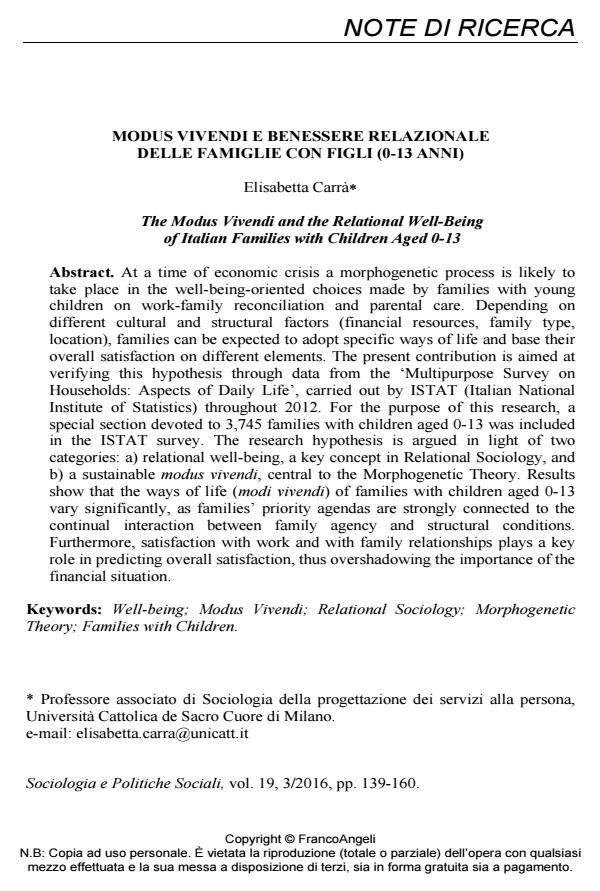The Modus Vivendi and the Relational Well-Being of Italian Families with Children Aged 0-13
Journal title SOCIOLOGIA E POLITICHE SOCIALI
Author/s Elisabetta Carrà
Publishing Year 2016 Issue 2016/3 Language Italian
Pages 22 P. 139-160 File size 278 KB
DOI 10.3280/SP2016-003009
DOI is like a bar code for intellectual property: to have more infomation
click here
Below, you can see the article first page
If you want to buy this article in PDF format, you can do it, following the instructions to buy download credits

FrancoAngeli is member of Publishers International Linking Association, Inc (PILA), a not-for-profit association which run the CrossRef service enabling links to and from online scholarly content.
At a time of economic crisis a morphogenetic process is likely totake place in the well-being-oriented choices made by families with youngchildren on work-family reconciliation and parental care. Depending ondifferent cultural and structural factors (financial resources, family type,location), families can be expected to adopt specific ways of life and base theiroverall satisfaction on different elements. The present contribution is aimed atverifying this hypothesis through data from the ‘Multipurpose Survey onHouseholds: Aspects of Daily Life’, carried out by ISTAT (Italian NationalInstitute of Statistics) throughout 2012. For the purpose of this research, aspecial section devoted to 3,745 families with children aged 0-13 was includedin the ISTAT survey. The research hypothesis is argued in light of twocategories: a) relational well-being, a key concept in Relational Sociology, andb) a sustainable modus vivendi, central to the Morphogenetic Theory. Resultsshow that the ways of life (modi vivendi) of families with children aged 0-13vary significantly, as families’ priority agendas are strongly connected to thecontinual interaction between family agency and structural conditions.Furthermore, satisfaction with work and with family relationships plays a keyrole in predicting overall satisfaction, thus overshadowing the importance of thefinancial situation.
Keywords: Well-being; Modus Vivendi; Relational Sociology; MorphogeneticTheory; Families with Children.
- Frey, B.S. and Stutzer, A. 2011. The use of happiness research for public policy. Social Choice Welfare, 38(4), pp. 659-674.
- AAVV. 2011. Il benessere oltre il Pil. Definire e misurare la qualità sociale. Rivista delle politiche sociali, 1.
- Archer, M.S. 2003. Structure, Agency and the Internal Conversation. Cambridge: Cambridge University Press.
- Beck, U. 1992. Risk Society. Towards a New Modernity. London: Sage Publications.
- Beck U., Giddens, A. and Lash, S. 1996. Reflexive Modernization. Cambridge: Polity Press.
- Caritas Italiana. 2014. Povertà e vulnerabilità dei genitori separati. Bisogni intercettati ed espressi nel circuito ecclesiale. Bologna: EDB.
- Carrà, E. 2008. Un’osservazione che progetta. Milano: Led.
- Clark, A. and Senik, C. 2011. Is happiness Different from Flourishing? Crosscountry evidence from the ESS. Working Paper 2011-04. Paris: School of Economics.
- Cnel. 2010. Le dimensioni del benessere costruzione e utilizzo di nuovi indicatori statistici a integrazione del PIL. Roma: Cnel.
- Deaton, A. 2011. The Financial Crisis and the Well-being of Americans. Oxford Economic Papers, 64, pp. 1-26.
- Deci, E. and Ryan, R. 2006. Hedonia, Eudaimonia, and Well-being: An introduction. Journal of Happiness Studies, 9. pp. 1-11.
- Doherty, W.J. 2013. The Citizen Professional: Working with Families and Communities on Problems People Care About. Italian Journal of Sociology of Education, 5(3), pp. 111-126.
- Dolan, P. and White, M. 2007. How Can Measures of Subjective Well-Being Be Used to Inform Public Policy?. Perspectives on Psychological Science, 2(1), pp. 71-85.
- Dolan, P., R. Layard and R. Metcalfe. 2011. Measuring Subjective Well-being for Public Policy. Newport: Office for National Statistics.
- Donati, P. 1998. Manuale di sociologia della famiglia. Bari: Laterza.
- — 1999. Quale “ben-essere” per la famiglia italiana?. In P. Donati a cura di. Famiglia e società del benessere, Sesto Rapporto Cisf sulla famiglia in Italia, pp. 357-372. Cinisello Balsamo: Edizioni San Paolo.
- — 2006. Dopo-moderno. In P. Donati a cura di. Sociologia, p. 269. Padova: Cedam.
- — 2013. Sociologia della relazione. Bologna: Il Mulino — 2014. Transcending Modernity: The Quest for a Relational Society, Cesis-Department of Sociology and Business Law, Bologna: University of Bologna.
- Helliwell, J.F. and Barrington-Leigh C.P. 2010. Measuring and Understanding SubjectiveWell-being, NBERWorking Paper, 15887. National Bureau of Economic Research.
- Huppert, F.A., Marks, N., Clark, A., Siegrist, J., Stutzer, A., Vitterso, J. and Wahrendorf, M. 2009. Measuring Well-being Across Europe: Description of the ESS Well-being Module and Preliminary Findings, Social Indicators Research, 91, pp. 301-315.
- International Wellbeing Group. 2006. Personal Wellbeing Index, 4th edition, Melbourne Australian Centre on Quality of Life, Deakin University.
- ISTAT. 2012. La soddisfazione dei cittadini per le condizioni di vita. Anno 2012. Roma: Istat.
- — 2013. BES 2013. Il benessere equo e sostenibile in Italia, Roma: Istat.
- Kahneman, D. and Krueger, A. 2006. Developments in the measurement of subjective well-being, The Journal of Economic Perspectives, 20(1), pp. 3-24. DOI: 10.1257/089533006776526030
- Nussbaum, M.C. 2003. Capabilities as Fundamental Entitlements: Sen and Social Justice. Feminist Economics, 9(2/3), pp. 33-59.
- OECD. 2011. How's life? 2013 - Measuring well-being, OECD Publishing.
- — 2013. OECD Guidelines on Measuring Subjective Well-being, OECD Publishing.
- ONS. 2012. Subjective Well-being User Guide: 12 Month Data Set, Office for National Statistics.
- Scabini, E. e Rossi, G. a cura di 2006. La parole della famiglia. Studi Interdisciplinari sulla famiglia, 31, Milano: Vita e Pensiero.
- Sen, A.K. 1985. Commodities and Capabilities. Oxford: Oxford University Press.
- Stiglitz, J.E., Sen, A. and Fitoussi, J.P. 2008. Report by the Commission on the Measurement of Economic Performance and Social Progress.
- Tinto, A. e della Ratta-Rinaldi, F. 2011. Le opinioni dei cittadini sulle misure del benessere, Roma: Cnel- ISTAT
- Van Praag, B.M.S., Frijters, P. and Ferrer-i-Carbonell, A. 2003. The Anatomy of Subjective Well-being. Journal of Economic Behaviour and Organisation, 51, pp. 29-49. DOI: 10.1016/S0167-2681(02)00140-3
Elisabetta Carrà, Modus vivendi e benessere relazionale delle famiglie con figli (0-13 anni) in "SOCIOLOGIA E POLITICHE SOCIALI" 3/2016, pp 139-160, DOI: 10.3280/SP2016-003009